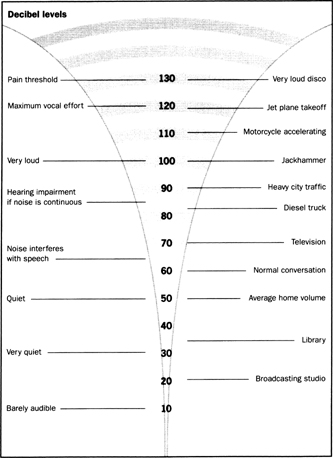The Environment and Health - Effects of sound on the eardrum
Noise is not just annoying; it is potentially dangerous, both physically and mentally. It has been described as “a slow agent of death.” A form of energy, sound or noise is caused by anything that vibrates, that moves back and forth. Our ears receive the effects of this vibrating motion from a distance, great or small, via sound waves. These waves are successive series of regions of compressed air and partial vacuums, or areas of high and low air pressure. Sound can also travel through liquids and solids. We hear sound because our eardrums are moved back and forth by the changes in air pressure. The eardrum, or tympanic membrane , may perceive a sound that moves it only one billionth of a centimeter—the threshold of hearing. If the intensity of sound pressure becomes too great, we experience pain, and the eardrum or the delicate structures inside the ear may be damaged.
The intensity of sounds is often measured in units called decibels , or db . These units are logarithmic, that is, 10 db is ten times as powerful as 1 db, 20 db is 100 times as powerful, 30 db is 1,000 times as powerful, and so on. On this scale, 0 db is at the threshold of hearing; rustling leaves, 20 db; a quiet office, about 50 db; conversation, 60 db; heavy traffic, 90 db; a pneumatic jackhammer six feet away, 100 db; a jet aircraft 500 feet overhead, 115 db; a Saturn rocket's takeoff, 180 db.

For most people, the pain threshold is about 120 db; deafening ear damage can result at 150 db. But damage of various kinds can come from much lower exposures. Temporary hearing impairment can result from sounds over the 85 db now found in modern kitchens with all appliances going. If the ears do not get a chance to recover, the impairment will become permanent.
Damage to the Inner Ear
Although very loud noise can damage the eardrum, most physiological damage from noise occurs in the snail-shaped, liquid-filled cochlea , or inner ear. Sound transmitted to the cochlea produces waves in the liquid, which in turn move delicate and minute structures called hair cells or cilia in that part of the cochlea known as the organ of Corti. The motion of the cilia is transformed into electrical impulses that conduct the sensation of sound to the brain.
The cilia can easily be fatigued by noise, causing a temporary loss of hearing, or a shift in the threshold of hearing. If they are not given a chance to recuperate, they will be permanently damaged, and irreversible hearing loss will result. There are some 23,000 cilia in the average cochlea; different sets of cilia respond to different frequency bands. The cilia responding to sound frequencies of 4,000 to 6,000 cps (cycles per second) are especially vulnerable to damage. The region of 85 to 95 db is generally regarded as the beginning of dangerous sound intensities. In general, the louder the noise, the longer it lasts, the higher it is, and the purer in frequency, the more dangerous it is. Thus, jet engines and powerful sirens are particularly hazardous.
Noise and Stress
The EPA has estimated that some 20 million Americans live or work at noise levels that could cause hearing losses; about 18 million have experienced at least some hearing loss because of noise exposure. But sound, or noise, can lead to physical and psychological problems ranging from irritability to migraine headaches. Linked with many such problems is stress, which has been found to cause high blood pressure, insomnia, ulcers, digestive disorders, alcoholism, anxiety, and many other ills.
Excessive noise has been implicated in such problems as adrenaline flow, elevated heart rates, and blood pressure. All are associated with heart disease. Noise can also affect children in special ways. For example, researchers believe it can retard language development and impair reading ability. Pregnant women exposed to excessive noise may show symptoms of stress and may pass on the harmful effects to their unborn babies. Studies in several countries have shown that the newborns of women living near airport runways experience a higher than normal incidence of birth defects.
Noise-related stress has a definite effect on mental well-being. No one knows exactly how, but noise can produce irritability, tension, and nervous strain. More seriously, British medical authorities have reported a significantly higher incidence of mental illness among people exposed constantly to aircraft noise.
Workplace Noise
Workplace noise presents special problems. Persons working in such industries as construction, mining, steel, lumber, and textiles are almost universally exposed to loud noises. Certain operations in other industries expose workers to high decibel levels. Overexposure takes place when employees work eight hours a day at sites with noise levels exceeding 90 decibels. Such standards, established by the government's Occupational Safety and Health Administration (OSHA), provide also that overexposure occurs where workers are subjected to higher decibel levels for shorter periods.
Workplace noise can lead to problems similar to those produced by-overexposure elsewhere. But many workers have little choice as regards the places where they work. For their parts, companies may have limited options insofar as noise control or abatement is concerned. Changing the gears of a machine or building an enclosure around it may not always be feasible.
Some professional musicians find it difficult or impossible to avoid excessive noise on the job. Rock music artists, for example, spend hours at a stretch in enclosed places that magnify sound that is already greatly amplified. Such persons may be at serious risk of incurring hearing losses.

Comment about this article, ask questions, or add new information about this topic: